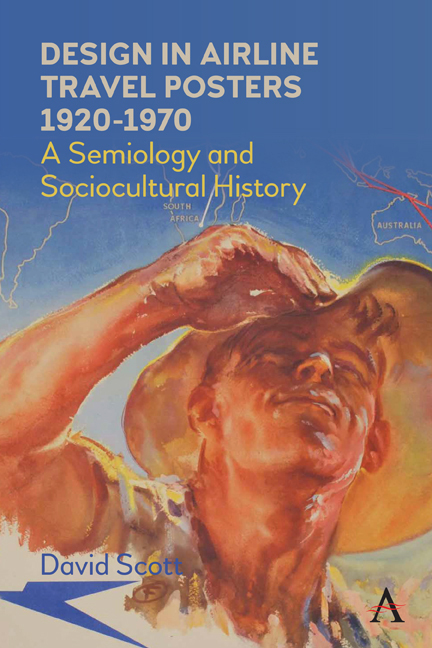Book contents
- Frontmatter
- Dedication
- Contents
- List of Figures
- Introduction
- 1 Fact and Fantasy: Reading and Misreading the Poster Image
- 2 People, Places and Planes: Destinations and Itineraries
- 3 Looking Out and Looking Up: Framing Devices and Indexical Signs
- 4 Indigenous Peoples
- 5 Glamour and Sex Appeal: Designing Desire
- Conclusion: The Decline of the Airline Travel Poster
- References
- Index
- Frontmatter
- Dedication
- Contents
- List of Figures
- Introduction
- 1 Fact and Fantasy: Reading and Misreading the Poster Image
- 2 People, Places and Planes: Destinations and Itineraries
- 3 Looking Out and Looking Up: Framing Devices and Indexical Signs
- 4 Indigenous Peoples
- 5 Glamour and Sex Appeal: Designing Desire
- Conclusion: The Decline of the Airline Travel Poster
- References
- Index
Summary
The field of poster studies is a vast one, but it is surprising how little work has been done to date on the fundamental structures – semiotic and semantic – that underpin the visual messages posters produce. Most studies of posters focus on their history (Müller-Brockman & Yoshikawa, 1971; Franciscono, 1987) – very often under the time-worn rubric ‘The Golden Age of …’ or equivalent periodic markers (Peignot, 1988; Morris, 1989), on specific themes – politics (Gervereau, 1991, 2000; Guillemain, 1991; Weill, 1995), travel (Weill, 1994), sport (Castiglioni, 1986; Durry, 1988), urban life (Moles, 1970), cinema – or on their status as collectable items. Although such approaches are undoubtedly valid, they hardly account for the specificity of the poster's appeal or for the complex semiotic and cultural issues poster art raises. Similarly, though there are a few books devoted to the study of advertising in aviation and air travel in national contexts (Purvis, 1992; Smit, Wunderlinck & Hooland, 1994; Scudiero, Cirulli & Cremoncini, 2002; Woodley, 2004; Cruddas, 2008), to date no book has taken a broader approach to both the form and the content, the medium and the message, of air travel posters. This book sets out to tackle these latter issues since they are fundamental both to the deeper significance and to the wider appeal of the poster as a cultural form, and to an understanding of air travel.
Since posters are cultural signs, to understand better how they work and the value attached to them even after their commercial or political message has been communicated, it is useful to analyse them in terms of both their sociocultural history and their semiological structure. The status of the poster as sign has to date been analysed in depth by Fresnault-Deruelle (1989, 1997) and Scott (2010), while its status as a social and cultural document has been extensively explored by Moles (1970), Spearritt (1990) and others. An illuminating survey of the social history of air travel has moreover been provided by Hudson and Pettifer (1979) and of the role of airline travel in tourism in Australia by Davidson and Spearritt (2010: chapter 10).
- Type
- Chapter
- Information
- Design in Airline Travel Posters 1920–1970A Semiology and Sociocultural History, pp. 1 - 6Publisher: Anthem PressPrint publication year: 2021



